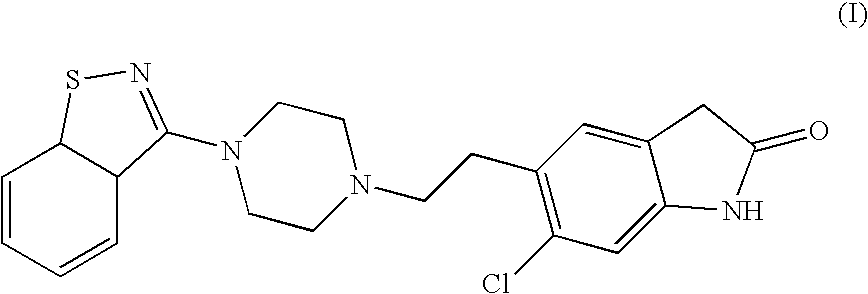Ziprasidone formulations
a technology of ziprasidone and formulation, applied in the field of ziprasidone formulation, can solve the problems of formulations that do not provide a constant or substantially constant level of ziprasidone, and certain properties that are not ideal
- Summary
- Abstract
- Description
- Claims
- Application Information
AI Technical Summary
Benefits of technology
Problems solved by technology
Method used
Image
Examples
example 1
Ziprasidone Monohydrochloride Particle Preparation Having an Average Particle Size of Greater than 85 Micrometers
[0317] Large crystals of ziprasidone monohydrochloride monohydrate may be prepared according to the following procedure. A clean and dry glass-lined reactor is charged with 180 liters (L) of tetrahydrofuran, 18 L of deionized water, and 6.0 kilograms (Kg) of ziprasidone free base. The slurry is heated to reflux, giving a clear solution. A hydrogen chloride (HCl) solution is prepared from 16 L of deionized water and 1.8 L of concentrated HCl in a separate charge tank. The agitator in the tank is set to the slow speed. The reactor is cooled to just below reflux (60-62° C.) and an initial 2 Kg of the HCl solution are added. The crystallization mixture is maintained at 62° C. for 30 minutes, thereby allowing seed crystals to develop. Following the stir period, the rest of the HCl solution is added over an additional 45 minute period. When the addition is complete, the slurry...
example 2
Amorphous Ziprasidone Dihydrochloride Dihydrate Formulation: Polyvinylpyrrolidone (PVP) 29 / 32K / Ziprasidone Dihydrochloride Dihydrate, 2:1 wt Basis, Oven Drying
[0318] To a 125 mL Erlenmeyer flask is added PVP 29 / 32K (8.1210 g) having a molecular weight distribution corresponding to 29 / 32K available from International Specialty Chemicals under the tradename PLASDONE, ziprasidone free base (4.62 g) and hot purified water (60° C., 48 mL). The Erlenmeyer flask is immersed in a water bath heated to 60° C. Hot 1.0 N HCl (60° C., 27.2 mL) is added to the 125 mL Erlenmeyer flask and stirred for approximately 5 minutes. Approximately 5 mL of the hot solution is transferred using a pipette to a pre-heated crystallization dish (60° C.) and allowed to dry in a tray oven at 60° C. for 71 hours. The solid product is tested by FTIR and x-ray powder diffraction to indicate the lack of crystalline peaks in the x-ray powder diffraction to indicate an absence of crystalline ziprasidone and that zipras...
example 3
Amorphous Ziprasidone Dihydrochloride Dihydrate Formulation: PVP 29 / 32K / Ziprasidone Dihydrochloride Dihydrate, 2:1 wt Basis, Vacuum Drying
[0319] Approximately 5 mL of the hot solution prepared in Example 1 is transferred using a pipette to a pre-heated 50 mL round bottom flask (60° C.). The sample is dried under static vacuum at 60° C. for 29 hours. The solid product is tested by FTIR and x-ray powder diffraction.
PUM
| Property | Measurement | Unit |
|---|---|---|
| Temperature | aaaaa | aaaaa |
| Fraction | aaaaa | aaaaa |
| Fraction | aaaaa | aaaaa |
Abstract
Description
Claims
Application Information
 Login to View More
Login to View More - R&D
- Intellectual Property
- Life Sciences
- Materials
- Tech Scout
- Unparalleled Data Quality
- Higher Quality Content
- 60% Fewer Hallucinations
Browse by: Latest US Patents, China's latest patents, Technical Efficacy Thesaurus, Application Domain, Technology Topic, Popular Technical Reports.
© 2025 PatSnap. All rights reserved.Legal|Privacy policy|Modern Slavery Act Transparency Statement|Sitemap|About US| Contact US: help@patsnap.com

